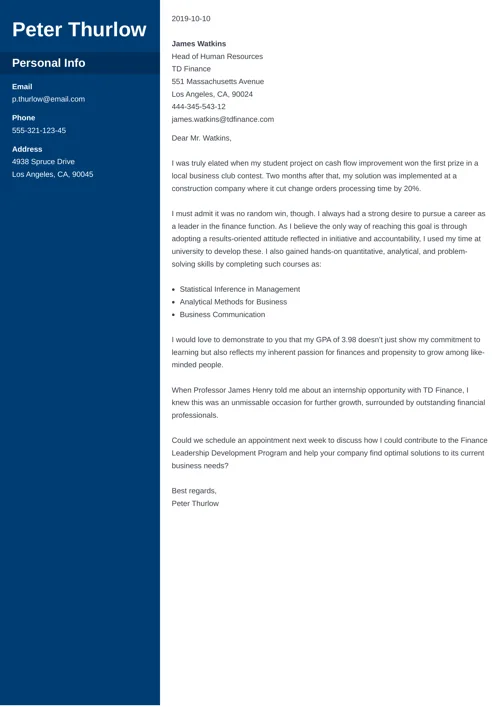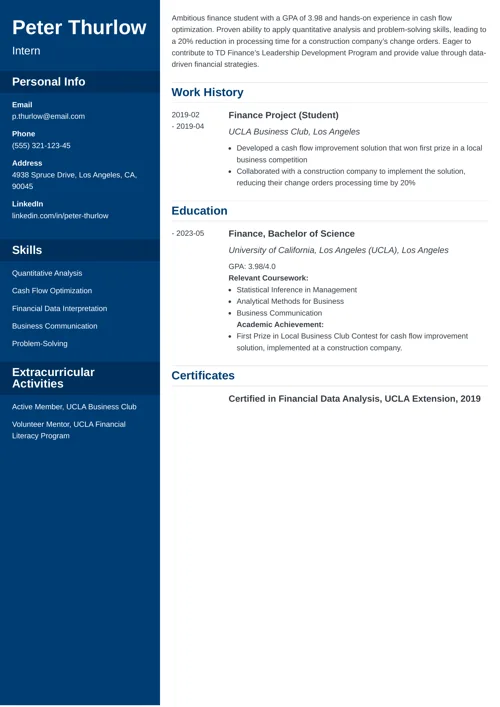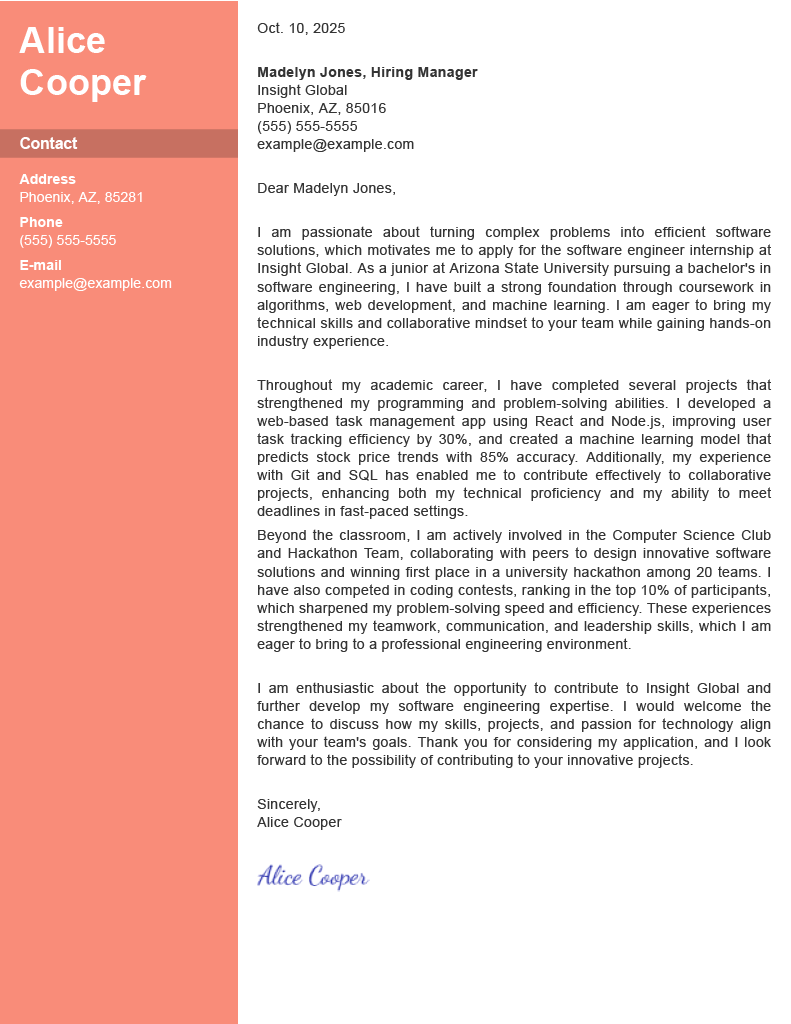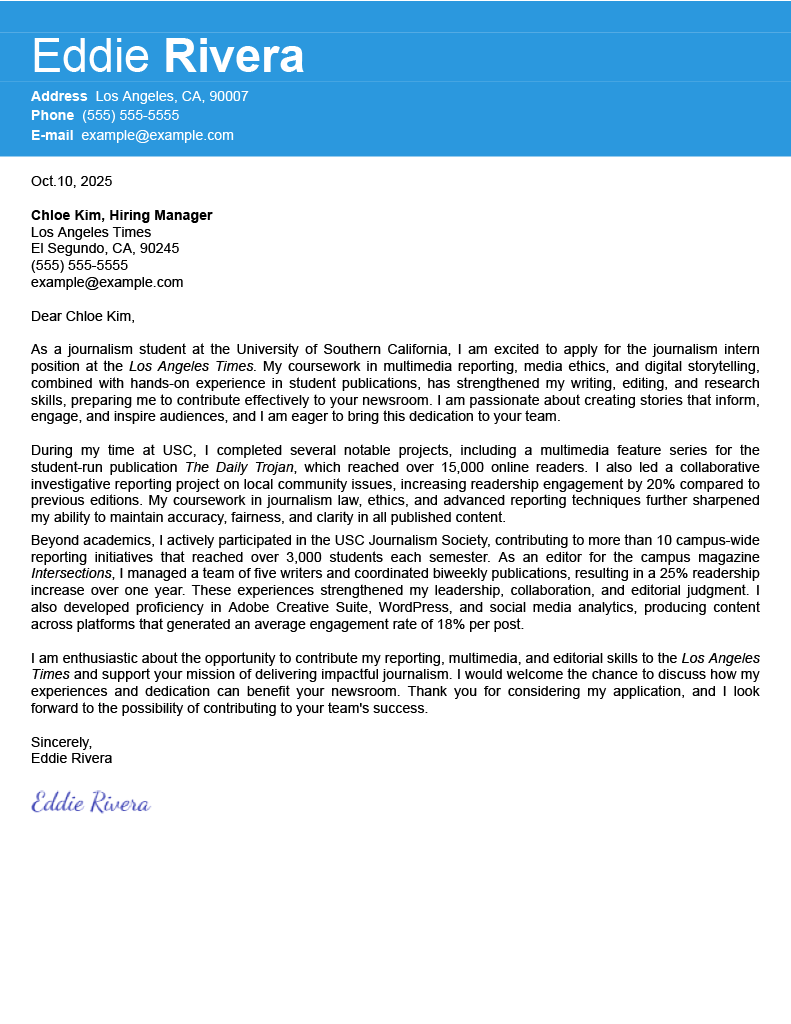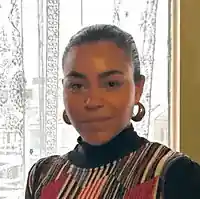An internship is your bridge between the classroom and the working world. But before you can cross it, you need to convince someone to give you a shot.
That's where your cover letter comes in. It helps you explain what you've learned, what you hope to achieve, and why you're excited to get started.
In this guide, you'll learn how to write a strong internship cover letter step by step—with expert tips, examples, and plenty of inspiration along the way.
Want to write your cover letter fast? Use our Cover Letter Builder. Choose from 20+ professional cover letter templates that match your resume. See actionable examples and get expert tips along the way.
Sample cover letter for a resume—See more cover letter samples here.
Send your cover letter for internship positions along with an internship resume that proves you’re the number one pick. See our guide: How to Write an Internship Resume
How to Make a Cover Letter for an Internship in 6 Steps
The goal of your internship cover letter is simple: Convince employers to give you a chance to gain real-world experience.
Use it to highlight what you’ve learned in your college courses, the projects you’ve completed, the clubs you’ve joined, and, most importantly, the skills you’ve built along the way.
Here’s how to pull it all together, step by step.
Step 1: Research the company
Before you start writing your cover letter, take the time to learn as much as you can about the company. Understanding its values, culture, and goals will help you show how your skills and interests align.
Check out the company's mission and vision, see how the company presents itself online or in the media, and look for any recent news or projects. This research will help you craft a stronger opening and show that you’ve done your homework.
Once you’ve gathered enough information, review your skills and experiences to highlight the ones that best match the company’s needs. These are the points you’ll want to feature in your letter.
Step 2: Format your cover letter
To make sure your cover letter gets noticed—and passes applicant tracking systems (ATS)—you need to format it correctly.
Follow these cover letter formatting rules:
- Keep your margins consistent. Set all margins to 1 inch on all sides and left-align your text.
- Choose a professional font. Standard fonts like Arial, Times New Roman, or Calibri make your letter easy to read and look polished.
- Set proper spacing. Use single or 1.15 line spacing throughout your letter.
- Use a simple file name. Save your letter as Internship-CoverLetter-YourName.pdf to keep it professional and easy to find.
Pro tip: Our cover letter templates follow standard formatting rules, and you can choose one that matches your resume to create a cohesive look to your application.
Step 3: Address the reader correctly
Start by addressing the hiring manager by name to establish a personal connection. If you're unsure of their gender or don’t want to make assumptions, use their full name (e.g., Dear Sydney Rivera).
If you know the reader's gender, use the title Mr. or Ms. For example:
- Dear Ms. Durant,
- Dear Mr. Ocasio,
Avoid outdated greetings like "Dear Sir/Madam" or "To Whom It May Concern" and informal ones like "Hello" or "Hi." If you don’t know the hiring manager’s name, you can use “Dear Hiring Manager” or address your letter to a department, such as “Dear HR Team” or “Dear Engineering Team.”
Step 4: Write an engaging introduction
Use your research to pull an interesting fact about the company's recent work that you can weave into your introduction to hook your reader.
Another attention-grabbing strategy is to lead with an achievement of yours that relates to the company's products, services, or mission.
The key is to show genuine interest and highlight your strengths. Avoid simply stating who you are and what you hope to gain. Make it about what you can contribute.
Take a look at this example:
| Wrong |
|---|
Hello, my name is Emily Johnson, and I am currently a junior at Boston University studying marketing. I am seeking an internship this summer to gain hands-on experience in the field. This internship will help me gain a deeper understanding of the industry, and I would be grateful for an opportunity to work with your team. |
This introduction is too general. It focuses on what Emily wants rather than what she can offer the company.
Now, see how a strong introduction might read:
| Right |
|---|
I was excited to learn about your “EcoStyle” campaign's recent success on social media. As a marketing junior at Boston University, I led a team project designing a social media campaign for a local eco-friendly clothing startup, where our posts increased engagement by 35% over two months. I believe my experience in content creation and passion for sustainability can help BrightWave Media develop creative campaigns that resonate with your audience. |
This introduction shows that Emily researched the company and understands a recent project it undertook. She connects her own relevant experience, including measurable results, to the company's goals. It demonstrates enthusiasm, specificity, and value, making her stand out as a strong candidate.
Step 5: Convince employers you’d be a great fit
Now that you've captured the reader's attention, it's time to prove you'd be a great addition to the team. Use the body paragraphs of your cover letter to connect what you've learned in school with what the company does.
Highlight your most relevant coursework, projects, or extracurricular activities that show your skills in action. This is where you can prove that even without years of experience, you have the knowledge, motivation, and hands-on practice to contribute from day one.
If it fits your letter, you can even use a short bullet list to showcase key coursework or projects that relate to the internship.
Let's continue with the earlier example:
| Wrong |
|---|
I believe I would be a great fit for your company because I’m a fast learner and work well in teams. During my time in college, I’ve taken several classes and joined clubs that have helped me grow as a student. I think these experiences have prepared me for this internship. |
This paragraph uses vague statements like “fast learner” and “team player” without providing proof. It also fails to show any specific coursework or activities that connect to the company’s needs.
| Right |
|---|
My coursework and campus involvement have prepared me to contribute to your company’s marketing team from day one. Over the past two years, I’ve gained hands-on experience applying marketing concepts in both class projects and extracurricular activities, such as:
Through these experiences, I’ve learned how to combine creativity with data-driven decision-making to build effective campaigns—a skill I’d love to bring to BrightWave Media’s growing portfolio. I’m confident that my academic foundation and enthusiasm for ethical marketing make me a strong fit for your internship program. |
This version ties specific experiences directly to the company’s focus and uses measurable results to back up claims. The bullet points make the content easy to scan while showing relevant coursework and leadership experience.
Step 6: Close with a call to action
Wrap up your cover letter by reinforcing your enthusiasm for the internship and thanking the reader for their time. End with a confident call to action that invites them to connect with you.
Avoid restating everything you’ve already said. Remind the reader why you’re excited about the opportunity and that you’d love to discuss how you can contribute to their team.
Here’s how you can end your letter:
| Example |
|---|
Thank you for considering my application. I'm eager to bring my creativity, strong research skills, and passion for sustainable branding to your team. I would like to discuss how my background and ideas can support your upcoming campaigns. |
Cover Letter Internship Template
Still need some help? We created this handy template you can use to start your cover letter:
[Your name]
[City, state, ZIP code]
[Your email address]
[Your phone number]
[Date]
[Hiring manager’s name]
[Company name]
[City, state, ZIP code]
Dear [Hiring Manager’s Name],
I was excited to learn about [specific internship title] at [Company Name], especially after reading about [a recent project, achievement, or company value that caught your attention]. As a [your major] student at [your university], I’ve developed skills in [relevant skills or areas of study] that I’m eager to apply to real-world projects at [Company Name].
My academic background and campus experiences have prepared me to contribute to your team from day one. Some of my most relevant experiences include:
- [Course or Project Name]: [Briefly describe what you did and what you learned—include any results or accomplishments if possible.]
- [Club or Extracurricular Activity]: [Explain your role, what you achieved, and how it connects to the internship.]
- [Additional Experience or Volunteer Work]: [Mention how this experience strengthened a skill or quality the company values.]
Through these experiences, I’ve built strong [mention two to three relevant skills, such as communication, teamwork, research, or technical abilities], which I’m excited to bring to [Company Name]. I’m especially drawn to this internship because [explain why this role or company aligns with your interests or career goals].
Thank you for considering my application. I’d love the opportunity to discuss how my skills and enthusiasm can contribute to [Company Name]’s [department, project, or goal]. I look forward to speaking with you soon.
Sincerely,
[Your Full Name]
Internship Cover Letter Examples
Use these cover letter examples for an internship to see how other students leverage their skills to create an impressive letter:
Software engineer internship cover letter
Journalism internship cover letter
5 Tips to Boost Your Internship Cover Letter
Before you hit send, take a few extra minutes to polish your cover letter. Follow these tips:
- Use strong action verbs. Start your bullet points and sentences with active verbs like "developed," "led," "created," or "analyzed" to make your achievements sound confident and results-driven.
- Include keywords. Review the job posting and weave in keywords the employer mentions. This shows you're a great match and helps your letter pass ATS.
- Keep it concise. Aim for no more than one page. Focus on the most relevant experiences and avoid repeating information from your resume.
- Proofread it. Read your letter out loud or use a grammar-checking tool to catch typos and awkward phrasing.
- Match your tone to the company culture. If the company seems formal, keep your tone professional. If it's more creative or relaxed, let a bit of your personality shine through.
Key Takeaways
Now you're ready to start your internship application process! Remember these key points:
- Knowing the company's values, culture, and recent projects helps you tailor your letter and hook the reader from the start.
- Format your letter professionally with consistent margins, readable fonts, proper spacing, and a clear file name.
- Lead your letter with a specific connection to the company or achievement.
- Use concrete examples to show your skills in action.
- Connect your knowledge and skills to the company's goals.
- Always proofread and keep your letter concise.
About Zety’s Editorial Process
This article has been reviewed by our editorial team to make sure it follows Zety's editorial guidelines. We’re committed to sharing our expertise and giving you trustworthy career advice tailored to your needs. High-quality content is what brings over 40 million readers to our site every year. But we don't stop there. Our team conducts original research to understand the job market better, and we pride ourselves on being quoted by top universities and prime media outlets from around the world.
